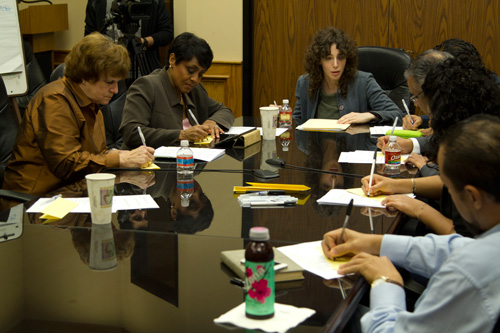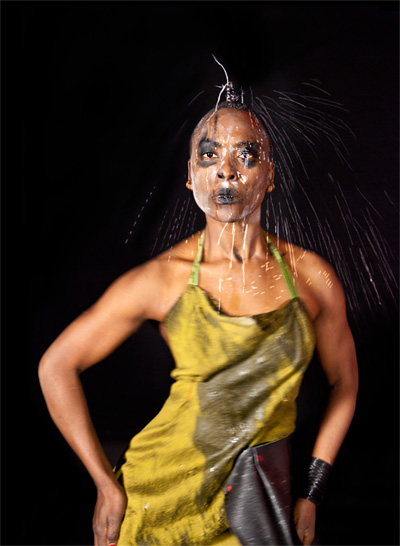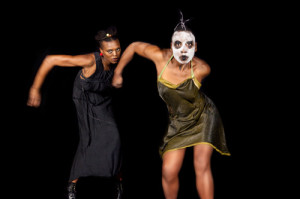Experiential Experiments

Liz Magic Laser, Tell Me What You Want to Hear, workshop documentation, February 2013.
Left to Right: Sue Lovell, Linda Lorelle, Liz Magic Laser, Felipe Campos, Mustafa Tameez, Lizette Garcia, Maurice Duhon. PHOTO: DIVERSEWORKS.
Liz Magic Laser and Nora Chipaumire at DiverseWorks
Presenting experimental, provocative, performance-driven work is nothing new for DiverseWorks, and this month is no different. On second thought, it’s quite different — at least in terms of what audiences may have come to expect.
First on the DiverseWorks calendar isTell Me What You Want To Hear, a video installation from artist Liz Magic Laser, recently named as the 2013 Armory Show commissioned artist. The project explores techniques of eliciting public empathy through storytelling and interviewing, as employed by politicians and newsmakers. You know the drill — polls and surveys, leading (or misleading) sound bites, and exaggerated headlines.
When Elizabeth Dunbar came onboard as the new DiverseWorks Executive Director in early 2012, she identified Laser as one of the first artists with whom she wanted to work.
“She immediately came to mind as a likely suspect for our programming,” says Dunbar, who soon invited Laser to present her work at DiverseWorks. At the time of the invitation neither party was certain whether or not that presentation would be of a new or an existing piece. Since DiverseWorks prefers to commission work whenever possible, it quickly became clear that a new piece was in the cards.
After approximately a year of production, refining, and redefining, Tell Me What You Want To Hear will debut this month with a live performance and gallery installation. The project adopts the format of a political talk show, complete with dialogue between political experts and the media, videotaped and edited in real time, plus live feedback from an invited audience — in a separate location — watching and responding through live-feed video. The result is a multi-channel video installation/exhibition that also includes research materials and documentation.

Nora Chipaumire.
Photo by Antoine Tempe.
Laser developed the piece through workshops with a group of Houston collaborators. Each member of the group contributed to the project through the lens of their experience in media, journalism, or communication. The group included local TV personalities, politicians, and University of Houston students.
“UH School of Communications devoted a special course to Liz’s project,” explains Dunbar. “The students are working on the production end of the piece and their input is crucial to its development.”
Together with Laser, the group identified a story they wanted to share, testing ways to make it as empathetic as possible and working within media-specific parameters such as time constraints and visual cues.
“One of the best things about this project is our ability to reach out to communities that are not usually included in the artistic process — for example, newscasters and political consultants. Here, they are becoming part of the artwork,” says Dunbar.
Through this, Tell Me What You Want To Hear reveals how messages are conveyed and how original content is repackaged in order to be more presentable and accessible for public consumption — the ethics and consequences of which are up for debate. “It’s an experiment for DiverseWorks. That’s what we like to do and that’s what we do best,” adds Dunbar.
Later this month and in conjunction with Austin’s Fusebox Festival — and in keeping with its experimental, provocative spirit — DiverseWorks also presents renowned Zimbabwean dance-theatre artist Nora Chipaumire and her work powerful, emotive work Miriam.
“Nora is one of the most riveting performers I’ve seen and that’s one of the reasons we wanted to bring her in. We committed to the project before knowing exactly what the work would be,” says Sixto Wagan, artistic director of DiverseWorks.
Wagan describes Miriam as an installation-performance — a non-narrative theatrical piece that involves movement, where heavy sculptural costumes and dramatic lighting, especially the lack of light, act as characters just as much as humans. A major component of the piece is for audience members to work to penetrate the darkness in order to see the performance.
Miriam begins ominously, with Chipaumire emerging feet first from a pile of rocks, then moving through layers of light and dark. She is confounded, yet responsive to voices and music — grunting, screeching, and moaning, oscillating between painful and ecstatic, fearful and remorseful. At times, performer Okwui Okpokwasili joins Chipaumire amid music, laughter, spotlight flashes, shadowy outlines, and a megaphone barking instructions.
In simple, descriptive terms, Miriam is about womanhood and heritage. A more complex interpretation reveals it to be deeply personal and political, concerned with exposing and challenging issues of femininity, race, darkness, fear, and complicity in relation to exile (in Chipaumire’s case, self-exile), otherness, and acceptance. The work is informed by legendary music, literature, politics and literature — represented by South African singer and activist Miriam Makeba, the 1902 Joseph Conrad novella The Heart of Darkness, and the life and iconography of Jesus’ mother, Mary.
The piece is no doubt difficult and challenging to experience, but Chipaumire wants audiences to become involved in the subject matter of the piece itself, to work for what they will learn. Miriam’s relevance to contemporary society makes the attempt at doing so all the more important.
-NANCY ZASTUDIL




Recent Comments